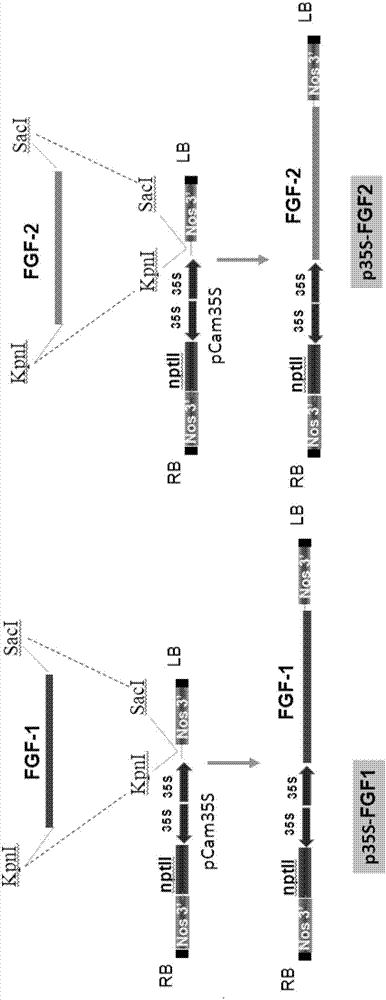Application of lettuce used as host to expressing growth factors
A growth factor and lettuce technology, applied in the direction of growth factor/inducing factor, fibroblast growth factor, application, etc., can solve problems such as hindering the development of plant exogenous protein drugs and increasing costs
- Summary
- Abstract
- Description
- Claims
- Application Information
AI Technical Summary
Problems solved by technology
Method used
Image
Examples
Embodiment 1
[0049] The construction of embodiment 1 plant transient expression vector
[0050] In order to provide high-efficiency expression of foreign aid proteins in plants, the present invention optimizes the codons of human FGF-1 (GenBank Accession No.: NM_001257210.1) and FGF-2 (GenBank Accession No.: M27968.1) to plant-preferred codons. Gene Art TM GeneOptimizer TM(ThermoFisher) designed and synthesized. Add Xbal and Kpnl restriction sites at the 5' end of the optimized FGF-1 and FGF-2 sequences, add Sacl and Pacl sites at the 3' end, and clone them into 17ABRZ5P_FGF1_pMA-T and 17ABRZ4P_FGF2_pMA-T vectors by ThermoFisher . Growth factor gene fragments FGF-1 and FGF-2 were isolated from 17ABRZ5P_FGF1_pMA-T and 17ABRZ4P_FGF2_pMA-T by Kpnl / Sacl, and cloned into the binary plant vector pCam35S to produce transient expression vectors p35S-FGF1 and p35S-FGF2, respectively. The two plant expression constructs were transformed separately into Agrobacterium tumefaciens GV3101 by electro...
Embodiment 2
[0052] Example 2 Agrobacterium-mediated vacuum infiltration
[0053] The present invention optimizes the method of Agrobacterium vacuum infiltration ( figure 2 ). The prepared Agrobacterium culture suspension was placed in a 2L beaker and placed in a desiccator. The lettuce kept in this laboratory was turned upside down (core up) and gently swirled in the bacterial suspension, and the desiccator was sealed. The vacuum pump (Welch Vacuum, Niles, IL, USA) was turned on to evacuate and the permeate was seen in the leaf tissue. Maintain the pressure state for 30-60 seconds. The system is quickly opened to release the pressure and allow permeate to seep into the spaces within the tissue. This process was repeated 2 to 3 times until it was clearly visible that the permeate diffused significantly in the lettuce tissue. The lettuce tissue was then gently removed from the permeate and rinsed three times consecutively with distilled water before being transferred to a container co...
Embodiment 3
[0055] Example 3 Protein Extraction and Separation
[0056] Lettuce samples vacuum-infiltrated with Agrobacterium were stirred with a stirrer and extracted with extraction buffer (100 mM KPi, pH 7.8; 5 mM EDTA; 10 mM at a ratio of 1:1 by volume). -Mercaptoethanol) high-speed homogenization in a blender for 1 to 2 minutes. The homogenate was adjusted to pH 8.0, filtered through gauze, and the filtrate was centrifuged at 10,000 g for 15 min at 4°C to remove cell debris. The supernatant was collected, mixed with ammonium sulfate (50%), and incubated with shaking on ice for 60 minutes. Centrifuge again (10,000 g) for 15 min at 4°C. The obtained supernatant was subjected to a second round of ammonium sulfate (70%) precipitation, shaken and suspended on ice for 60 min, and centrifuged again at 10,000 g for 15 min at 4°C. Then, the supernatant was discarded, and the protein precipitated from the treated sample was dissolved in 5 mL buffer (20 mM KPi, pH 7.8; 2 mM EDTA; -mercapt...
PUM
 Login to View More
Login to View More Abstract
Description
Claims
Application Information
 Login to View More
Login to View More - R&D
- Intellectual Property
- Life Sciences
- Materials
- Tech Scout
- Unparalleled Data Quality
- Higher Quality Content
- 60% Fewer Hallucinations
Browse by: Latest US Patents, China's latest patents, Technical Efficacy Thesaurus, Application Domain, Technology Topic, Popular Technical Reports.
© 2025 PatSnap. All rights reserved.Legal|Privacy policy|Modern Slavery Act Transparency Statement|Sitemap|About US| Contact US: help@patsnap.com



